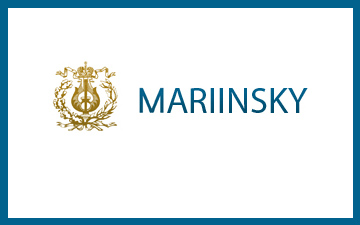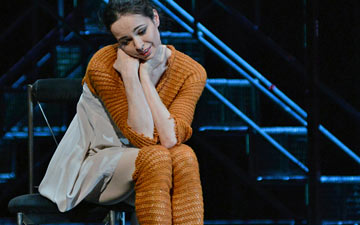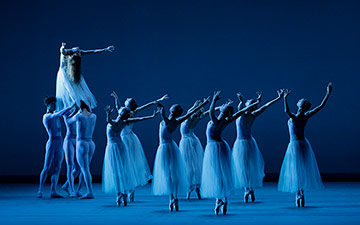
Mariinsky Ballet
Cinderella, The Enchanted Wanderer (opera)
New York, Brooklyn Academy of Music
18 January 2015
www.mariinsky.ru
www.bam.org
Portrait of the Artist as a Young Man
Just a few weeks in, 2015 is turning out to be a banner year for ballet in New York. Only last week, a small group from the Royal Danish Ballet had balletomanes flocking to the Joyce like religious pilgrims, eager to pray at the altar of Bournonville. And now, after a four-year absence, the legendary Mariinsky is back in town. Uncharacteristically the company – both opera and ballet – has chosen to perform on the cramped stage of the Howard Gilman Opera House at the Brooklyn Academy of Music. (It had no choice, given that both the Met and the Koch are currently occupied.)
Of one thing we can be sure: the Mariinsky orchestra, particularly under the baton of Valery Gergiev, is reason enough to catch one of these performances. (Gergiev’s politics, on the other hand, are worthy of discussion, as a group of anti-Putin protesters outside the hall reminded us on opening night.) For dance lovers, accustomed to competent but seldom transcendent music-making, it is easy to forget what a difference a great orchestra can make, how it amplifies and deepens the impact of even the most familiar score. In the two Mariinsky performances I’ve caught so far, of Rodion Shchedrin’s opera The Enchanted Wanderer and Prokofiev’s Cinderella, the orchestra’s lush, shimmering sound has been an almost overwhelming presence.
Gergiev, the undisputed commissar of Russian music, is also the artistic director of the Mariinsky, overseeing both opera and ballet. The repertory reflects his tastes. He is an unabashed champion of the music of Rodion Shchedrin; during the last New York tour, many of the ballets were set to music by Shchedrin, a master of orchestral color if not the most original of composers. This time Gergiev has elected to bring another Shchedrin opus, The Enchanted Wanderer, a kind of Russian extravaganza filled with resounding choruses, keening tenor melodies in the style of the “holy fool” of Boris Godunov, exclamations about the Russian soul and melismatic gypsy laments. It’s a beguiling but hollow work. The Mariinsky orchestra and singers – the bass Oleg Sychov, tenor Andrei Popov and mezzo Kristina Kapustinksaya – conveyed it with gorgeousness of sound and stylistic nuance.
Last night the orchestra once again made a powerful impression, this time in Prokofiev’s 1945 ballet Cinderella. The orchestral shadings were extraordinary – alternatively dream-like, singing, mocking, jazzy. Individual instruments shone: a sudden string quartet rising through the thick orchestral texture during the overture, or, in the final bars of the last act, a solitary violin and flute denoting the human dimension of the love between Cinderella and her prince. But despite such musical revelations, Cinderella proves itself a difficult score, not particularly suited to telling a story through dance. Its fragmented structure, full of starts and stops and insistent repetitions, leaves the choreographer grasping for ways to keep the story moving along.
The choreographer in question is Alexei Ratmansky, recognized as one of the most imaginative and original ballet storytellers working today. But this Cinderella is an early work (from 2002, before he was known outside of Russia) and his relative inexperience is evident here, not least in his evident struggle against the ups and downs of the music. The momentum is particularly slack in the first act, where Prokofiev paints a series of musical caricatures, returning to them again and again. The ugly stepsisters’ squabbles, the stepmother’s grotesque vanity, Cinderella’s loneliness, all are stated and re-stated in intercutting mini-scenes. As a result, the choreography feels stuck in a see-saw of description and inaction. (In his witty 1948 version, Frederick Ashton was able to solve this through the sheer variety, detail and humor of his mime.) Ratmansky’s portraits are drawn in broad strokes, too broad to be funny. It’s telling that the only secondary character to make much of an impression is Cinderella’s father (played by Soslan Kulaev), a figure ignored in other versions of the story. He’s depicted as a sad drunk, a man who has lost all dignity, reduced to begging his own daughter for a few coins. His trembling sad-sack solo is a little jewel in what is otherwise a rather frustrating first act.
The production is further shackled by some unfortunate costume designs by Elena Markovskaya. The overall look, conceived by Ilya Utkin and Yevgeny Monakhov, is industrial. The first act is dominated by two staircases of the kind one might see on a construction site. The backdrop of the second act is an architectural drawing of a palatial domed structure. An enormous metal wheel hangs overhead, suggesting at first a clock and then a giant chandelier. All fine. But the punk hairdos, face-paint, and color-coded unitards of the spirits who come to pay their respects to Cinderella before the ball suggest an esthetic that may have seemed edgy in St. Petersburg in 2002 but now looks simply garish. The sisters’ fluorescent-colored hairdos and disheveled tutus are not much better. The fairy godmother, who facilitates Cinderella’s transformation from wallflower to belle of the ball, is a bag lady in oversized shoes, a clownish tramp. A nice idea that goes nowhere.
Even so, the ballet has intriguing elements. Much of the choreography for the women – Cinderella, sisters and party guests – is an in-depth exploration of the range and possibilities of pointe-work. The dancers walk, stomp, tap, jab, teeter, hop, shimmy and slide, all on pointe. They use their pointes as weapons or comical props, and as tools for hoisting themselves on and off balance. Also striking is the use of the dancers’ upper bodies: loose, slinky, twisted, flopping, scooping. Ratmansky seems bent on breaking the rules of classical deportment, seeing how far he can twist and bend the shoulders and torso. It’s striking to see the Mariinsky’s dancers, normally so elegant and exquisitely coordinated, move with such freedom. In this sense, Cinderella is a kind of workshop of ideas about movement and about ballet.
On January 18, the Ukrainian-born soloist Anastasia Matvienko was a pliant, loose-limbed Cinderella who danced with uninhibited ease and looked perfectly at home in Ratmansky’s goofy interpretation of the character, all flailing legs and arms and scooping upper body. (Matvienko was trained in Kiev and danced at the Mikhailovsky until 2009.)
Her prince, the soloist Alexander Sergeyev, was similarly excellent, stylish and wry, with beautiful clean jumps and beats of the legs, a supple back, and silken transitions. The two had a playful rapport – in Ratmansky’s mind they’re more like teenagers than adults. She’s a gawky outsider, he’s the homecoming king, privileged but pure of heart. At the ball they converse heatedly in secret hand semaphores that no-one else can understand. Then, back on her home turf, Cinderella makes her presence known by dropping a shoe on the prince’s head from her perch above the stage. Their first pas de deux is a bit meandering and hard to follow but the second, though not one of Ratmansky’s greatest essays in romantic love, is suitably swoony, with a theme of rounded arms and subtly-twisting partnering.
Generally speaking, the middle act is the most effective, particularly the ballroom scene, which Ratmansky fills with 1920’s poses and popular dances like the Charleston. Again, the pointe-work is ingenious, as is the patterning and layering of the ensembles. Another inspired passage is an all-male dance during the prince’s whirlwind search for the owner of the abandoned slipper. In this unidentified foreign land, evoked by Prokofiev’s suitably exotic music, the men partake in sultry folk dances, complicated by seductive male-on-male partnering. It’s a kind of tongue-in-cheek version of Maurice Béjart’s glorification of the male form in Sept Danses Grecques. For a fleeting moment, the prince is tempted to forgo his search and explore the local delights.
Cinderella is not a great ballet; in fact it’s odd that the Mariinsky regularly chooses to take it on tour. (Ratmansky made a completely new version for the Australian Ballet just last year, which implies that he himself has moved on.) But it is not without interest. It suggests a choreographer finding his way, unafraid to try new things. It’s a workshop of ideas out of which have emerged tools that Ratmansky has used more effectively in ballets like The Bright Stream, The Little Humpbacked Horse, Namouna, and even the recent Pictures at an Exhibition. And it reveals an imagination that is utterly unique, more than a little bit weird, and unabashedly his own. That, in itself, is refreshing.

















You must be logged in to post a comment.